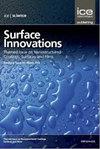超疏水表面上的液滴脱漆:从简单的刚性润湿到复杂的软润湿
IF 3.5
4区 材料科学
Q3 CHEMISTRY, PHYSICAL
引用次数: 6
摘要
在超疏水表面上进行液滴脱毛在自然界中很普遍,对许多应用都很关键,因此在过去几十年中进行了广泛的研究。人们一致认为,液滴脱钉力主要来源于三相接触线和液气界面的协同动力学。尽管如此,上述结论是使用简单(纯水)液滴在刚性超疏水表面上脱钉得出的,称为简单刚性润湿,其中主要影响因素是液-汽界面张力、表面纹理几何形状和材料润湿性。近年来,人们越来越关注复杂的软润湿,其中液体的物理化学性质(如粘弹性)和固体表面刚性起着重要作用。为了鼓励对复杂软润湿的研究,从这个角度出发,将简要介绍在软表面上对简单液滴的脱钉和在刚性表面上对粘弹性液滴的去钉。然后,将讨论影响粘弹性液滴在柔软的超疏水表面上脱毛的可能因素。此外,将介绍与复杂软润湿高度相关的应用。本文章由计算机程序翻译,如有差异,请以英文原文为准。
Droplet depinning on superhydrophobic surfaces: From simple rigid wetting to complex soft wetting
Droplet depinning on superhydrophobic surfaces is pervasive in nature and critical to many applications and hence has been studied extensively over the past few decades. A consensus has been reached that the droplet depinning force mainly stems from the synergistic dynamics of the three-phase contact line and the liquid-vapor interface. Nevertheless, the above conclusions were made using simple (pure water) droplets depinning on rigid superhydrophobic surfaces, denoted as simple rigid wetting, where the main influencing factors are liquid-vapor interfacial tension, surface texture geometry, and material wettability. In recent years, an increasing amount of attention has been paid to complex soft wetting, where liquid physiochemical properties (e.g., viscoelasticity) and solid surface rigidity play an important role. To encourage the investigation of complex soft wetting, in this perspective, depinning of simple droplet on soft surfaces and depinning of viscoelastic droplets on rigid surfaces will be briefly introduced. Then, possible factors that affect viscoelastic droplet depinning on soft superhydrophobic surfaces will be discussed. Moreover, applications that are highly relevant to complex soft wetting will be introduced.
求助全文
通过发布文献求助,成功后即可免费获取论文全文。
去求助
来源期刊

Surface Innovations
CHEMISTRY, PHYSICALMATERIALS SCIENCE, COAT-MATERIALS SCIENCE, COATINGS & FILMS
CiteScore
5.80
自引率
22.90%
发文量
66
期刊介绍:
The material innovations on surfaces, combined with understanding and manipulation of physics and chemistry of functional surfaces and coatings, have exploded in the past decade at an incredibly rapid pace.
Superhydrophobicity, superhydrophlicity, self-cleaning, self-healing, anti-fouling, anti-bacterial, etc., have become important fundamental topics of surface science research community driven by curiosity of physics, chemistry, and biology of interaction phenomenon at surfaces and their enormous potential in practical applications. Materials having controlled-functionality surfaces and coatings are important to the manufacturing of new products for environmental control, liquid manipulation, nanotechnological advances, biomedical engineering, pharmacy, biotechnology, and many others, and are part of the most promising technological innovations of the twenty-first century.
 求助内容:
求助内容: 应助结果提醒方式:
应助结果提醒方式:


